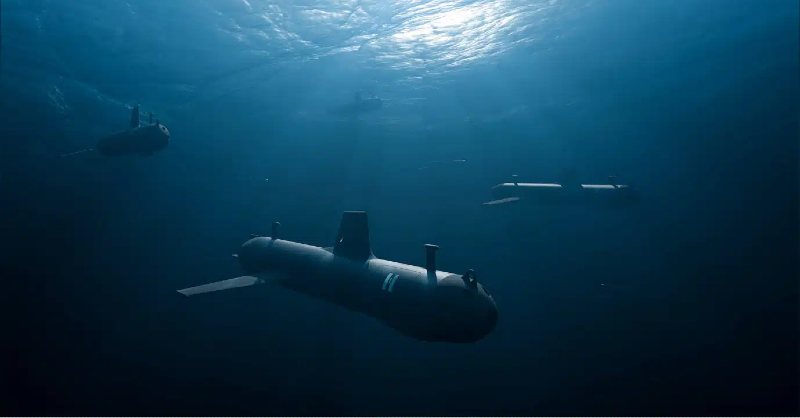AI beneath the waves: Helsing’s AI submarine Lura redefines Europe’s undersea defence

Submarines have long been pivotal in naval warfare, offering stealth, endurance, and the ability to project power unseen. Traditionally manned and expensive, these vessels are now being complemented by autonomous underwater vehicles (AUVs), which provide cost-effective solutions for surveillance, reconnaissance, and protection of critical undersea infrastructure. The evolution of AUVs signifies a shift towards more agile and persistent maritime defence strategies.
European defence technology startup Helsing has unveiled Lura, an advanced AI system integrated into the SG-1 Fathom autonomous mini-submarine. Compact yet capable, the SG-1 Fathom measures approximately 1.95 metres in length, has a diameter of 28 cm, and weighs just 60 kg. Its design is inspired by underwater gliders, utilising a sophisticated buoyancy engine instead of traditional propellers.
Lura functions as a large acoustic model (LAM), akin to large language models but tailored for sound. Trained on decades of subsurface acoustic data, Lura enables the SG-1 to classify and pinpoint acoustic signatures of various vessels with remarkable precision. The system has four passive sonars, allowing it to detect sounds at volumes ten times quieter and process data forty times faster than traditional human operators. Unlike active sonar, which can reveal a submarine’s presence, these passive sensors silently monitor the underwater environment, maintaining stealth.
These autonomous submarines can be deployed in large numbers, forming a networked “constellation” that enhances maritime surveillance capabilities. This approach increases coverage and provides a scalable solution to monitor vast oceanic regions, which is crucial for safeguarding undersea cables and deterring unauthorised submarine activities.
Hundreds of SG-1 Fathoms can be launched simultaneously, each operating autonomously and briefly surfacing to transmit critical intelligence via satellite. A single operator at a maritime headquarters can oversee the entire constellation, receiving actionable data at a fraction of the cost of traditional crewed anti-submarine patrols.
Since its inception in 2021, Helsing has rapidly ascended in the defence technology sector. In September 2023, the companysecured €209 million in Series B funding, led by General Catalyst, with participation from Swedish defence firm Saab. This was followed by a substantial€450 million investment in July 2024, elevating Helsing’s valuation to approximately €5 billion.
Helsing’s strategic collaborations extend to prominent defence entities such as Airbus, Rheinmetall, and Saab, focusing on integrating AI into existing military platforms. The company’s AI systems have been deployed in various applications, including enhancing the radar capabilities of the Saab JAS 39 Gripen and contributing to the Future Combat Air System. Additionally, Helsing has partnered with Mistral AI to develop “vision-language-action” models to improve decision-making processes in complex combat scenarios.
In June 2024, Helsing signed a framework agreement with Airbus Defence and Space to develop AI technologies for the “Wingman” system – an unmanned fighter aircraft designed to operate alongside crewed jets like the Eurofighter. This expansion beyond maritime applications demonstrates Helsing’s growing influence across multiple defence domains.
The integration of AI and autonomous systems is reshaping the battlefield. In maritime, autonomous underwater vehicles like the SG-1 Fathom are becoming indispensable for intelligence gathering, surveillance, and reconnaissance missions. These systems offer persistent monitoring capabilities, which are crucial for detecting and deterring potential threats to undersea infrastructure.
Incidents like the 2022 Nord Stream pipeline sabotage, which highlighted vulnerabilities in undersea assets, have underscored the strategic importance of such technologies. In response, European nations are investing heavily in defence technologies, with the EU’s “ReArm Europe” plan aiming to mobilise up to €800 billion over the next four years to bolster military capabilities.
Helsing operates in a competitive global environment, with US-based companies like Anduril Industries, Shield AI, and Skydio leading in autonomous defence technologies. Anduril, for instance, has developed the Orca extra-large unmanned undersea vehicle (XLUUV) for the U.S. Navy, capable of long-range missions with minimal human intervention.
These companies have secured significant funding, withAnduril raising $1.5 billion in a Series E round,reflecting the growing investor confidence in defence tech startups. The competition underscores the strategic race to develop and deploy advanced autonomous systems for national security.
In March 2025,Shield AI completed a$240 million Series F-1 strategic funding round, achieving a valuation of $5.3 billion. This round saw significant participation from strategic investors, including existing investors, includingAndreessen Horowitz.
The deployment of AI-powered autonomous submarines like Helsing’s SG-1 Fathom represents a significant advancement in maritime defence. These systems offer scalable, cost-effective solutions for persistent surveillance and protection of critical undersea infrastructure.
As geopolitical tensions persist and technological capabilities evolve, the integration of AI and autonomous systems will become increasingly central to defence strategies. Helsing’s innovations exemplify the transformative potential of such technologies, heralding a new era in undersea warfare where agility, scalability, and intelligence are paramount.
Dr Gundbert Scherf, Co-founder and Co-CEO of Helsing, emphasised the strategic importance of underwater surveillance: “Lura detects so our navies can deter. We must harness new technologies to keep pace with the threats against our critical infrastructure, national waters, and way of life. Deploying AI to the edge of underwater constellations will illuminate the oceans and deter our adversaries, for a strong Europe.”
Amelia Gould, General Manager of Helsing Maritime, commented: “To protect ourselves from increasing threats, especially underwater, we must do defence differently. The UK has a proud history of maritime innovation and must never stand still. Lura and SG-1 will form an ever-evolving mission cycle, learning from each deployment to iterate at the pace of the threat – a true 21st-century defence capability.”

Published on Other News Site
















